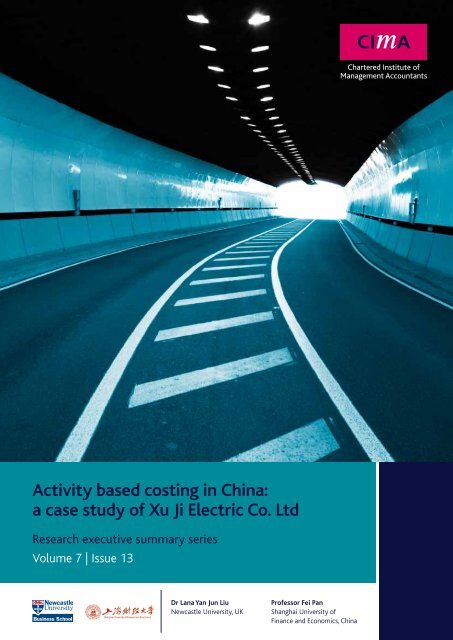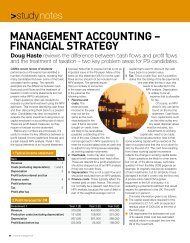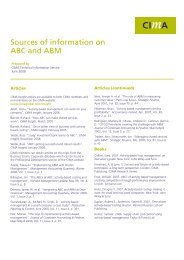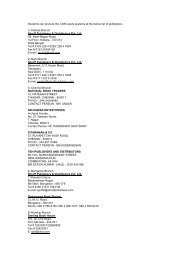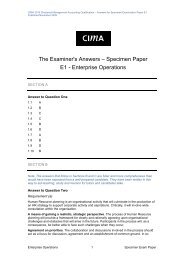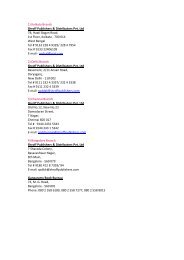Activity based costing in China: a case study of Xu Ji Electric ... - CIMA
Activity based costing in China: a case study of Xu Ji Electric ... - CIMA
Activity based costing in China: a case study of Xu Ji Electric ... - CIMA
Create successful ePaper yourself
Turn your PDF publications into a flip-book with our unique Google optimized e-Paper software.
<strong>Activity</strong> <strong>based</strong> <strong>cost<strong>in</strong>g</strong> <strong>in</strong> Ch<strong>in</strong>a:<br />
a <strong>case</strong> <strong>study</strong> <strong>of</strong> <strong>Xu</strong> <strong>Ji</strong> <strong>Electric</strong> Co. Ltd<br />
Research executive summary series<br />
Volume 7 | Issue 13<br />
Dr Lana Yan Jun Liu<br />
Newcastle University, UK<br />
Pr<strong>of</strong>essor Fei Pan<br />
Shanghai University <strong>of</strong><br />
F<strong>in</strong>ance and Economics, Ch<strong>in</strong>a
Key f<strong>in</strong>d<strong>in</strong>gs:<br />
• This ABC model is used to capture direct costs and variable overheads, which were<br />
lack<strong>in</strong>g <strong>in</strong> the SOE’s traditional <strong>cost<strong>in</strong>g</strong> systems.<br />
• The ABC experience has successfully <strong>in</strong>duced standardisation <strong>in</strong> their work<strong>in</strong>g<br />
practices and processes. Standardisation was not a common notion <strong>in</strong> Ch<strong>in</strong>ese<br />
culture or <strong>in</strong> place <strong>in</strong> many Ch<strong>in</strong>ese companies.<br />
• ABC also acts as a catalyst to <strong>Xu</strong> <strong>Ji</strong>’s IT developments – first account<strong>in</strong>g and <strong>of</strong>fice<br />
computerisation, and later the ERP implementation.<br />
• The common ‘top-down’ management style and organisational culture among SOEs<br />
worked well when <strong>in</strong>stigat<strong>in</strong>g <strong>in</strong>novative ideas and <strong>in</strong>duc<strong>in</strong>g corporate-wide learn<strong>in</strong>g.<br />
• Top management’s commitment to try<strong>in</strong>g out new management ideas and <strong>in</strong>vest<strong>in</strong>g<br />
<strong>in</strong> new technology has been the unique feature <strong>in</strong> this research organisation.
Executive summary<br />
This project <strong>in</strong>vestigated the implementation <strong>of</strong> activity-<strong>based</strong><br />
<strong>cost<strong>in</strong>g</strong> (ABC) at <strong>Xu</strong> <strong>Ji</strong> <strong>Electric</strong> Co. Ltd (<strong>Xu</strong> <strong>Ji</strong>), a large Ch<strong>in</strong>ese<br />
manufactur<strong>in</strong>g company. <strong>Xu</strong> <strong>Ji</strong> is a state-owned enterprise (SOE),<br />
turned public limited company (PLC). The company piloted<br />
ABC implementation <strong>in</strong> one <strong>of</strong> its ma<strong>in</strong> production divisions <strong>in</strong><br />
December 2001, when ABC concepts were at a theoretical level<br />
<strong>in</strong> Ch<strong>in</strong>a (Liu and Pan, 2007). Two more attempts to extend the<br />
use <strong>of</strong> ABC <strong>in</strong> one <strong>of</strong> its subsidiaries and sales functions took<br />
place <strong>in</strong> 2005 and 2008. Major events took place dur<strong>in</strong>g the<br />
latter research endeavour, <strong>in</strong>clud<strong>in</strong>g two major acquisitions<br />
– first by a pension fund and later by the national grid and<br />
recent decision to implement an enterprise resource plann<strong>in</strong>g<br />
(ERP) system. These events provided a unique opportunity to<br />
unveil factors pert<strong>in</strong>ent to organisational decisions towards<br />
<strong>in</strong>formation system implementation, to extract ‘real-life’<br />
<strong>in</strong>teractions between personnel at various organisational<br />
hierarchies; and to evaluate complex relationships between<br />
changes, organisational and <strong>in</strong>dividual learn<strong>in</strong>g.<br />
Ch<strong>in</strong>ese management styles rely more on manag<strong>in</strong>g people<br />
and relationships – Ch<strong>in</strong>ese management ethos – than on<br />
technological systems and management tools. The level <strong>of</strong><br />
<strong>of</strong>fice and account<strong>in</strong>g computerisation and IT-enabled bus<strong>in</strong>ess<br />
solutions is not as advanced as those <strong>in</strong> the west. <strong>Xu</strong> <strong>Ji</strong> started<br />
from a very basic level, build<strong>in</strong>g f<strong>in</strong>ancial account<strong>in</strong>g systems<br />
and <strong>of</strong>fice computerisation before implement<strong>in</strong>g the ABC<br />
system which captured direct costs and variable manufactur<strong>in</strong>g<br />
overheads before process<strong>in</strong>g.<br />
The ma<strong>in</strong> achievements <strong>of</strong> <strong>Xu</strong> <strong>Ji</strong>’s ten year ABC endeavour are<br />
that ABC radically changed the SOE, turned PLC’s traditional<br />
<strong>cost<strong>in</strong>g</strong> systems and <strong>in</strong>duced standardisation <strong>in</strong> their work<strong>in</strong>g<br />
practices and processes. ABC also acts as a catalyst to <strong>Xu</strong> <strong>Ji</strong>’s IT<br />
developments – first account<strong>in</strong>g and <strong>of</strong>fice computerisation and<br />
later the ERP implementation.<br />
One dist<strong>in</strong>ctive feature <strong>of</strong> <strong>Xu</strong> <strong>Ji</strong>’s ABC experience is the ‘topdown’<br />
<strong>in</strong>stigation and enthusiasm <strong>of</strong> try<strong>in</strong>g out <strong>in</strong>novative<br />
ideas and <strong>in</strong>duc<strong>in</strong>g corporate-wide learn<strong>in</strong>g. While such a<br />
‘top-down’ approach is not so popular <strong>in</strong> the west, it is fairly<br />
common amongst SOEs, particularly <strong>in</strong> the northern part <strong>of</strong><br />
Ch<strong>in</strong>a. This approach worked well <strong>in</strong> <strong>Xu</strong> <strong>Ji</strong>, allow<strong>in</strong>g them to<br />
move quickly from imitat<strong>in</strong>g western ideas to develop<strong>in</strong>g their<br />
own – <strong>in</strong>dependently developed Relay’s ABC system – and make<br />
<strong>in</strong>formed decisions us<strong>in</strong>g sales activity analysis.<br />
1 | <strong>Activity</strong> <strong>based</strong> <strong>cost<strong>in</strong>g</strong> <strong>in</strong> Ch<strong>in</strong>a: a <strong>case</strong> <strong>study</strong> <strong>of</strong> <strong>Xu</strong> <strong>Ji</strong> <strong>Electric</strong> Co. Ltd<br />
Key issues<br />
The key issues underly<strong>in</strong>g the research project are whether an<br />
ABC technique can be successfully implemented <strong>in</strong> a Ch<strong>in</strong>ese<br />
organisational sett<strong>in</strong>g and how ABC <strong>in</strong>formation can be used<br />
effectively to support Ch<strong>in</strong>ese management decision mak<strong>in</strong>g.<br />
Many advanced management account<strong>in</strong>g techniques orig<strong>in</strong>ated<br />
<strong>in</strong> developed economies – for example, ABC from the US and<br />
target <strong>cost<strong>in</strong>g</strong>/kaizen <strong>cost<strong>in</strong>g</strong> from Japan. These techniques have<br />
<strong>in</strong>evitable impr<strong>in</strong>ts <strong>of</strong> the cultures from which they orig<strong>in</strong>ated.<br />
Therefore <strong>in</strong> order to obta<strong>in</strong> real benefits from these advanced<br />
management account<strong>in</strong>g techniques, one should take serious<br />
account <strong>of</strong> one’s own management ethos and organisational<br />
and national culture (Nishimura, 2005).<br />
The Ch<strong>in</strong>ese economy has been boom<strong>in</strong>g for three decades,<br />
ma<strong>in</strong>ly due to the availability <strong>of</strong> abundant labour at relatively<br />
competitive prices <strong>in</strong> the manufactur<strong>in</strong>g sector. Ch<strong>in</strong>ese<br />
companies have been advanc<strong>in</strong>g their competitiveness through<br />
rapidly developed advanced manufactur<strong>in</strong>g and <strong>in</strong>formation<br />
systems. By contrast, advancements <strong>in</strong> management account<strong>in</strong>g<br />
techniques and IT-enabled bus<strong>in</strong>ess solutions have been<br />
pa<strong>in</strong>fully slow.<br />
This research co<strong>in</strong>cided with some major organisational changes,<br />
<strong>in</strong>clud<strong>in</strong>g a cash crisis caused by rapid expansions <strong>in</strong> 2003-2007,<br />
two acquisitions dur<strong>in</strong>g 2008-2011 and an ERP implementation<br />
that began <strong>in</strong> 2010 (see Appendix 1). In addition, <strong>Xu</strong> <strong>Ji</strong> has<br />
decided to delay further ref<strong>in</strong>ement <strong>of</strong> the ABC system until<br />
the completion <strong>of</strong> the ERP implementation. Nevertheless the<br />
project provides a rich account <strong>of</strong> how ABC systems <strong>in</strong>tertw<strong>in</strong>e<br />
with organisational changes; how ABC implementation enhances<br />
<strong>in</strong>dividual and organisational learn<strong>in</strong>g; and how the Ch<strong>in</strong>ese<br />
management ethos promote and/or impede the ABC adoption.
F<strong>in</strong>d<strong>in</strong>gs – <strong>Xu</strong> <strong>Ji</strong>’s ABC systems<br />
ABC system at the first production division 1<br />
Prior to the ABC <strong>in</strong>troduction <strong>in</strong> 2001, <strong>Xu</strong> <strong>Ji</strong> operated a<br />
traditional Ch<strong>in</strong>ese state-enterprise account<strong>in</strong>g system (see<br />
Figure 1). A large amount <strong>of</strong> manual book keep<strong>in</strong>g work was<br />
<strong>in</strong>volved. Account<strong>in</strong>g was driven predom<strong>in</strong>antly by external<br />
f<strong>in</strong>ancial report<strong>in</strong>g purposes and <strong>in</strong>accuracy <strong>of</strong> product costs<br />
became <strong>in</strong>evitable.<br />
At this time, <strong>Xu</strong> <strong>Ji</strong> underwent a series <strong>of</strong> flotations (Liu and<br />
Pan 2007), follow<strong>in</strong>g Ch<strong>in</strong>a’s <strong>in</strong>troduction <strong>of</strong> free market<br />
competition. <strong>Xu</strong> <strong>Ji</strong>, as a former SOE used to produce products<br />
<strong>based</strong> on a state production quota and was forced to face<br />
up the market competition. The <strong>in</strong>accuracy <strong>of</strong> the traditional<br />
<strong>cost<strong>in</strong>g</strong> <strong>in</strong>formation seriously impeded <strong>Xu</strong> <strong>Ji</strong>’s ability to compete<br />
on pric<strong>in</strong>g. <strong>Xu</strong> <strong>Ji</strong> urgently needed a better <strong>cost<strong>in</strong>g</strong> system so<br />
commissioned ABC implementation. The two ma<strong>in</strong> tasks for the<br />
ABC system were:<br />
• to trace direct labour costs directly to product and client<br />
contracts<br />
• to allocate manufactur<strong>in</strong>g overheads on the basis <strong>of</strong> up-todate<br />
direct labour hours to contracts.<br />
Figure 1: <strong>Xu</strong> <strong>Ji</strong>’s traditional <strong>cost<strong>in</strong>g</strong> system<br />
Direct material<br />
Direct labour<br />
Overheads<br />
Directly charged to<br />
Allocated <strong>based</strong> on standard<br />
direct labour rate*<br />
2 | <strong>Activity</strong> <strong>based</strong> <strong>cost<strong>in</strong>g</strong> <strong>in</strong> Ch<strong>in</strong>a: a <strong>case</strong> <strong>study</strong> <strong>of</strong> <strong>Xu</strong> <strong>Ji</strong> <strong>Electric</strong> Co. Ltd<br />
The ABC system was successfully implemented <strong>in</strong> 2003 after<br />
some teeth<strong>in</strong>g problems were solved. Some problems <strong>in</strong>cluded<br />
compatibility <strong>of</strong> <strong>in</strong>formation systems and mis<strong>in</strong>terpretation <strong>of</strong><br />
ABC concepts by IT programmers (see Figure 2).<br />
In 2004, the organisation was restructured <strong>in</strong>to <strong>in</strong>dependent<br />
companies – i.e. electricity grid, <strong>in</strong>dustrial electric and energy.<br />
Internal management structures were subsequently changed,<br />
which resulted <strong>in</strong> abandonment <strong>of</strong> some activity cost drivers.<br />
For example, new management <strong>of</strong> product l<strong>in</strong>e test<strong>in</strong>g and<br />
eng<strong>in</strong>eer<strong>in</strong>g design activity cost centres switched to other<br />
forms <strong>of</strong> monitor<strong>in</strong>g front-l<strong>in</strong>e performance <strong>in</strong>stead <strong>of</strong> us<strong>in</strong>g<br />
respective test<strong>in</strong>g labour hours and design hours (see Table 1).<br />
Therefore, test<strong>in</strong>g labour hour and design hour <strong>in</strong>formation was<br />
not updated and perceived to be ‘extra work’ by front-l<strong>in</strong>e data<br />
<strong>in</strong>put staff.<br />
There have been cont<strong>in</strong>uous and rapid organisational structural<br />
and management changes s<strong>in</strong>ce 2003. For example, changes to<br />
the management structure led to a merger <strong>of</strong> panel <strong>in</strong>stallation,<br />
panel wir<strong>in</strong>g and wire labell<strong>in</strong>g activity cost centres, to become<br />
one <strong>in</strong>dependent pr<strong>of</strong>it centre. A fixed value was decided<br />
between top and l<strong>in</strong>e managers to assign to each panel,<br />
however managers claimed they referred to the orig<strong>in</strong>al ABC<br />
cost to set the value. Nevertheless some quantitative cost<br />
Production<br />
department<br />
1, 2, 3<br />
Product<br />
contract<br />
1, 2, 3<br />
*Note: In <strong>Xu</strong> <strong>Ji</strong>, direct labour cost – <strong>in</strong>stead <strong>of</strong> be<strong>in</strong>g charged directly to products – was allocated first to production departments then to f<strong>in</strong>ished products.<br />
This practice was common <strong>in</strong> some Ch<strong>in</strong>ese manufactur<strong>in</strong>g companies as it was relatively difficulty to track direct labour to <strong>in</strong>dividual products without us<strong>in</strong>g<br />
sophisticated tools such as Manufactur<strong>in</strong>g Resource Plann<strong>in</strong>g (MRP) systems or some elaborate record<strong>in</strong>g mechanism with<strong>in</strong> a mass production.<br />
1 In 2001, <strong>Xu</strong> <strong>Ji</strong>’s ma<strong>in</strong> production departments comprised <strong>of</strong> the first production department (FPD) and second production department (SPD). FPD<br />
manufactures <strong>Xu</strong> <strong>Ji</strong>’s high yield products such as high-voltage electric equipment. SPD manufactures relatively low yield products such as safety and<br />
automation systems.
drivers – e.g. number <strong>of</strong> leads – faced threats <strong>of</strong> be<strong>in</strong>g nonrecorded<br />
or <strong>in</strong>accurately recorded. Managers gradually moved to<br />
use pr<strong>of</strong>it and/or revenue measures to monitor performances.<br />
These changes have limited the impact <strong>of</strong> ABC system and<br />
accuracy <strong>of</strong> ABC <strong>in</strong>formation.<br />
ABC system at the Relay subsidiary<br />
<strong>Xu</strong> <strong>Ji</strong> Relay company manufactures many different relay<br />
products and sells <strong>in</strong>ternally to other <strong>Xu</strong> <strong>Ji</strong> subsidiaries as well as<br />
outsiders. The organisational structure is <strong>in</strong>dependent to the rest<br />
<strong>of</strong> the group and has full f<strong>in</strong>ancial autonomy. Relay operates <strong>in</strong><br />
a highly competitive and saturated market, so its ma<strong>in</strong> aim has<br />
been to survive and avoid closure. An urgent need was to get<br />
Figure 2: The process <strong>of</strong> <strong>Xu</strong> <strong>Ji</strong>’s ABC system – 2002<br />
3 | <strong>Activity</strong> <strong>based</strong> <strong>cost<strong>in</strong>g</strong> <strong>in</strong> Ch<strong>in</strong>a: a <strong>case</strong> <strong>study</strong> <strong>of</strong> <strong>Xu</strong> <strong>Ji</strong> <strong>Electric</strong> Co. Ltd<br />
their product costs right, as commented by one <strong>of</strong> its managers<br />
that, ‘Our sell<strong>in</strong>g prices were all over the place as we did not know<br />
exactly how much it cost us to make one relay, would one type <strong>of</strong><br />
relay cost more or less, to top it all, we were mak<strong>in</strong>g losses, large<br />
unsold stocks…’<br />
With the lessons learnt from the ABC implementation, <strong>Xu</strong> <strong>Ji</strong>’s<br />
ABC team, together with Relay accountants and the s<strong>of</strong>tware<br />
company – which developed FPD’s ABC system – embarked<br />
on develop<strong>in</strong>g its own ABC system at Relay <strong>in</strong> late 2004. The<br />
cost structure <strong>in</strong> Relay comprised 85% direct materials and<br />
15% direct labour, variable and fixed overheads. Dur<strong>in</strong>g the<br />
implementation, the team realised the ma<strong>in</strong> <strong>in</strong>accuracy <strong>of</strong><br />
Warehouse Payroll Fixed assets General ledgers External data<br />
Resources: raw material, salaries, depreciation,<br />
other expenditures and other data<br />
Traceable to product l<strong>in</strong>es Not directly traceable to product l<strong>in</strong>es<br />
<strong>Activity</strong> cost centres<br />
Contract costs<br />
<strong>Activity</strong> cost centres<br />
Use relevant activity drivers to allocate<br />
Use activity cost drivers to allocate
product costs was not the use <strong>of</strong> out <strong>of</strong> date planned material<br />
cost <strong>in</strong>formation but the lack <strong>of</strong> standardised work<strong>in</strong>g practices<br />
and lack <strong>of</strong> <strong>in</strong>ventory control. Relay still recorded <strong>in</strong>ventory<br />
manually. Huge discrepancies between account<strong>in</strong>g figures<br />
and physical stock were treated as monthly manufactur<strong>in</strong>g<br />
overheads. <strong>Xu</strong> <strong>Ji</strong>’s top management decided to <strong>in</strong>vest <strong>in</strong> <strong>of</strong>fice<br />
computerisation at Relay. The first step was to develop a<br />
Table 1: Sample <strong>of</strong> activity cost centres and cost drivers – 2002<br />
Department <strong>Activity</strong> cost centres Cost drivers<br />
General Basic research and development Forecasted product l<strong>in</strong>e revenue<br />
Market<strong>in</strong>g F<strong>in</strong>ished contract revenue<br />
General adm<strong>in</strong>istration Number <strong>of</strong> employees at each product l<strong>in</strong>e<br />
Production Panel <strong>in</strong>stallation Number <strong>of</strong> panels<br />
Panel wir<strong>in</strong>g Number <strong>of</strong> leads<br />
Set <strong>of</strong> term<strong>in</strong>als Number <strong>of</strong> panels<br />
Wire labell<strong>in</strong>g Number <strong>of</strong> leads<br />
<strong>Electric</strong> <strong>case</strong> test<strong>in</strong>g Test labour hours<br />
Material management F<strong>in</strong>ished contract revenue<br />
Management F<strong>in</strong>ished contract revenue<br />
Warehouse management F<strong>in</strong>ished contract revenue<br />
Department <strong>Activity</strong> cost centres Cost drivers<br />
Product l<strong>in</strong>e Customised research & development Contract forecasted revenue<br />
Product l<strong>in</strong>e test<strong>in</strong>g Test labour hours<br />
Eng<strong>in</strong>eer<strong>in</strong>g design Design hours<br />
Market<strong>in</strong>g research F<strong>in</strong>ished contract revenue<br />
Onsite test<strong>in</strong>g and ma<strong>in</strong>tenance F<strong>in</strong>ished contract revenue<br />
Management F<strong>in</strong>ished contract revenue<br />
4 | <strong>Activity</strong> <strong>based</strong> <strong>cost<strong>in</strong>g</strong> <strong>in</strong> Ch<strong>in</strong>a: a <strong>case</strong> <strong>study</strong> <strong>of</strong> <strong>Xu</strong> <strong>Ji</strong> <strong>Electric</strong> Co. Ltd<br />
computerised material cost record<strong>in</strong>g system <strong>in</strong> order to capture<br />
the actual material quantity <strong>in</strong>formation and stock movements<br />
between warehouse and assembly l<strong>in</strong>es. In addition, standardised<br />
procedures for record<strong>in</strong>g and <strong>in</strong>ventory control were put <strong>in</strong><br />
place and enforced by build<strong>in</strong>g <strong>in</strong>to employees’ personal key<br />
performance <strong>in</strong>dicators (KPIs). It took Relay nearly four years<br />
between 2005 and 2008 to fully embed these changes.
After a trial run <strong>in</strong> 2009, Relay’s ABC system started to produce<br />
monthly ABC reports (see Figure 3). The ABC system matched<br />
its organisational structure and cost drivers for allocat<strong>in</strong>g facility<br />
susta<strong>in</strong><strong>in</strong>g costs are shown <strong>in</strong> Table 2.<br />
In 2010 Relay achieved a record annual sales <strong>in</strong>crease <strong>of</strong> 50%<br />
higher than 2009 and a net pr<strong>of</strong>it marg<strong>in</strong> <strong>in</strong>crease <strong>of</strong> 13%. Staff<br />
Table 2: Relay’s activity cost centres and cost drivers<br />
Departments <strong>Activity</strong> cost centres Cost drivers<br />
Facility susta<strong>in</strong><strong>in</strong>g costs<br />
General Executive <strong>of</strong>fice Number <strong>of</strong> assemble l<strong>in</strong>e employees<br />
F<strong>in</strong>ance Number <strong>of</strong> assemble l<strong>in</strong>e employees<br />
Technical support Chief eng<strong>in</strong>eer <strong>of</strong>fice Proportion <strong>of</strong> product revenue <strong>of</strong> assemble l<strong>in</strong>es<br />
Technical support <strong>of</strong>fice Proportion <strong>of</strong> product revenue <strong>of</strong> assemble l<strong>in</strong>e<br />
Production Production Proportion <strong>of</strong> product revenue <strong>of</strong> assemble l<strong>in</strong>e<br />
Warehouse Proportion <strong>of</strong> product revenue <strong>of</strong> assemble l<strong>in</strong>e<br />
Market<strong>in</strong>g Market<strong>in</strong>g Proportion <strong>of</strong> product revenue <strong>of</strong> assemble l<strong>in</strong>e<br />
Assemble l<strong>in</strong>e costs<br />
After-sales Proportion <strong>of</strong> product revenue <strong>of</strong> assemble l<strong>in</strong>e<br />
Assemble l<strong>in</strong>es Direct relay Direct labour hours<br />
Intermediate relay Direct labour hours<br />
Transformer Direct labour hours<br />
Timer relay Direct labour hours<br />
Wr<strong>in</strong>g assemble Direct labour hours<br />
WGB assemble Direct labour hours<br />
Transform relay Direct labour hours<br />
Intermediate transform replay Direct labour hours<br />
Signal relay Direct labour hours<br />
Packag<strong>in</strong>g Direct labour hours<br />
5 | <strong>Activity</strong> <strong>based</strong> <strong>cost<strong>in</strong>g</strong> <strong>in</strong> Ch<strong>in</strong>a: a <strong>case</strong> <strong>study</strong> <strong>of</strong> <strong>Xu</strong> <strong>Ji</strong> <strong>Electric</strong> Co. Ltd<br />
members at Relay ga<strong>in</strong>ed positive experience from the ABC<br />
implementation. The Relay accountant commented, ‘I am now<br />
very confident at our product costs. In turn our market<strong>in</strong>g people<br />
can compete faster and better <strong>in</strong> our market places.’
Added the manager, ‘In our Relay markets, tim<strong>in</strong>g is very<br />
important. We can now give quotes <strong>in</strong> a click <strong>of</strong> button. We do<br />
not keep large stock now and produce on order. Our material cost<br />
Figure 3: ABC process at Relay<br />
Raw materials<br />
Executive <strong>of</strong>fice<br />
Direct Relay<br />
Directly traced to<br />
Chief eng<strong>in</strong>eers<br />
<strong>of</strong>fice<br />
Intermediate Relay<br />
Transformer<br />
F<strong>in</strong>ance <strong>of</strong>fice<br />
Production<br />
plann<strong>in</strong>g <strong>of</strong>fice<br />
6 | <strong>Activity</strong> <strong>based</strong> <strong>cost<strong>in</strong>g</strong> <strong>in</strong> Ch<strong>in</strong>a: a <strong>case</strong> <strong>study</strong> <strong>of</strong> <strong>Xu</strong> <strong>Ji</strong> <strong>Electric</strong> Co. Ltd<br />
Market<strong>in</strong>g<br />
Facility susta<strong>in</strong><strong>in</strong>g costs<br />
Timer Relay<br />
Assemble l<strong>in</strong>es<br />
Wir<strong>in</strong>g assemble<br />
WGB assemble<br />
Product costs<br />
record<strong>in</strong>g system gives us actual cost <strong>in</strong>formation. This <strong>in</strong> turn has<br />
made our staff more aware <strong>of</strong> cost sav<strong>in</strong>gs. For example they now<br />
make full use <strong>of</strong> one piece material before discard<strong>in</strong>g it...’<br />
Still Relay assemble<br />
Warehouse<br />
Technical<br />
support<br />
Transform Relay<br />
assemble<br />
After-sales<br />
Use appropriate cost drivers to allocate<br />
Intermediate transform<br />
Relay assemble<br />
Signal Relay assemble<br />
Packag<strong>in</strong>g
ABC analysis at the sales companies<br />
The sales companies used to be subsidiaries <strong>of</strong> <strong>Xu</strong> <strong>Ji</strong> Group (XJG)<br />
– see Figure 4.<br />
Prior to the realignment, <strong>Xu</strong> <strong>Ji</strong> had no direct control over the<br />
ways <strong>in</strong> which the sales companies. operated as XJG decided<br />
on sell<strong>in</strong>g prices <strong>of</strong> products transferred from <strong>Xu</strong> <strong>Ji</strong> to the sales<br />
companies. Be<strong>in</strong>g a traditional production unit, <strong>Xu</strong> <strong>Ji</strong> did not<br />
have any market<strong>in</strong>g and sales expertise. The realignment <strong>of</strong><br />
Figure 4: A schematic diagram <strong>of</strong> <strong>Xu</strong> <strong>Ji</strong>’s data flow process – 2001<br />
Customers<br />
Tender<br />
bids<br />
Sales companies<br />
XJG 1<br />
Production<br />
plann<strong>in</strong>g<br />
division<br />
<strong>Xu</strong> <strong>Ji</strong> PLC 3<br />
Receive<br />
contracts<br />
Forward customer’s contracts<br />
Mechanic<br />
Chemical<br />
Pressure<br />
Heat<br />
Place production plans <strong>based</strong><br />
on contracts<br />
Place component production<br />
plans to assembly divisions<br />
Notes:<br />
1. The sales companies <strong>of</strong> XJG is an <strong>in</strong>dependent bus<strong>in</strong>ess unit, which deals with all sales orders for the group. The sales companies charges <strong>Xu</strong> <strong>Ji</strong> for relevant<br />
expenses except the salary costs <strong>of</strong> its sales staff.<br />
2. Yi Wan Logistic is one <strong>of</strong> the subsidiaries <strong>of</strong> the group and the sole authorised purchas<strong>in</strong>g company for the group. The company purchases all raw materials<br />
and components which are not manufactured <strong>in</strong>ternally. Yi Wan Logistics charges a commission <strong>of</strong> 0.1% for all purchases.<br />
3. The ma<strong>in</strong> functions <strong>of</strong> the production plann<strong>in</strong>g division are to set production plans <strong>based</strong> on customers’ specifications and place production orders to both<br />
production departments and component assembly divisions.<br />
Source: Liu and Pan (2007)<br />
7 | <strong>Activity</strong> <strong>based</strong> <strong>cost<strong>in</strong>g</strong> <strong>in</strong> Ch<strong>in</strong>a: a <strong>case</strong> <strong>study</strong> <strong>of</strong> <strong>Xu</strong> <strong>Ji</strong> <strong>Electric</strong> Co. Ltd<br />
some sales functions with the three companies brought <strong>Xu</strong><br />
<strong>Ji</strong> much needed sales and market<strong>in</strong>g expertise. However <strong>Xu</strong><br />
<strong>Ji</strong> top management still did not have enough know-how to<br />
manage the sales operations, sales people or expenses control.<br />
For example, <strong>Xu</strong> <strong>Ji</strong>’s CFO commented that, ‘I wanted to know<br />
what the <strong>in</strong>dustry norm is <strong>in</strong> terms <strong>of</strong> sell<strong>in</strong>g expenses over sales<br />
revenue… it gets more complicated when you need to spend or<br />
<strong>in</strong>vest now to build relationships, <strong>in</strong> order to get future bus<strong>in</strong>ess or<br />
contracts. What is the balance?’<br />
<strong>Xu</strong> <strong>Ji</strong> co. Ltd<br />
The first production<br />
department 1<br />
The second<br />
production<br />
Power switch<br />
department<br />
Other production<br />
departments<br />
Internal transfer <strong>of</strong> assembled components<br />
Transfer <strong>of</strong> f<strong>in</strong>ished products to sales companies<br />
Suppliers<br />
Yi Wan<br />
logistic 2<br />
Purchase<br />
material<br />
Place<br />
material<br />
purchase<br />
orders
The manag<strong>in</strong>g director <strong>of</strong> <strong>Electric</strong>ity Grid stressed that, ‘Our<br />
ABC system is basically to capture direct costs and manufactur<strong>in</strong>g<br />
overheads, over which an average <strong>of</strong> 80% is the cost <strong>of</strong> raw<br />
materials, determ<strong>in</strong>ed by the markets. We have done work to<br />
streaml<strong>in</strong>e our processes as well as to control our costs s<strong>in</strong>ce [the<br />
ABC implementation]. We managed to become very lean. Other<br />
costs such as management and sales expenses have been creep<strong>in</strong>g<br />
up year on year and are outside <strong>of</strong> the ABC system. So it is now<br />
time to take a closer look at these costs and f<strong>in</strong>d ways to control<br />
them…’<br />
Table 3: <strong>Activity</strong> analysis <strong>of</strong> sales and proposed activity cost drivers<br />
8 | <strong>Activity</strong> <strong>based</strong> <strong>cost<strong>in</strong>g</strong> <strong>in</strong> Ch<strong>in</strong>a: a <strong>case</strong> <strong>study</strong> <strong>of</strong> <strong>Xu</strong> <strong>Ji</strong> <strong>Electric</strong> Co. Ltd<br />
The researchers teamed up with the <strong>Xu</strong> <strong>Ji</strong> ABC team and set up a<br />
project team, aim<strong>in</strong>g at undertak<strong>in</strong>g a detailed analysis <strong>of</strong> sales<br />
activities at the three sales companies. The orig<strong>in</strong>al objectives<br />
were to establish appropriate activity cost drivers which<br />
l<strong>in</strong>ked sales expenses to contracts and to <strong>in</strong>corporate the sales<br />
expenses <strong>in</strong>to the exist<strong>in</strong>g ABC system.<br />
Based on detailed analysis, the sales expenses were analysed<br />
<strong>in</strong>to stages <strong>based</strong> on the nature <strong>of</strong> sales activities and associated<br />
cost drivers were proposed <strong>in</strong> Table 3.<br />
Sales expenses (activity <strong>in</strong>volved) <strong>Activity</strong> level Proposed cost drivers<br />
Front-stage – market<strong>in</strong>g activities to enter new<br />
markets and/or general pr<strong>of</strong>ile-rais<strong>in</strong>g activities<br />
Salaries*<br />
Travell<strong>in</strong>g costs<br />
Market<strong>in</strong>g materials<br />
Mid-stage – contracts-related<br />
Facility-level Average or other subject measures – e.g.<br />
geographic sales percentage<br />
NB: general expenditures with no apparent or<br />
specific contracts<br />
Salaries <strong>of</strong> sales staff Susta<strong>in</strong><strong>in</strong>g-level Geographic area – first trace to geographic areas<br />
then allocated to contracts value <strong>in</strong> geographic<br />
area<br />
Travell<strong>in</strong>g costs Susta<strong>in</strong><strong>in</strong>g-level<br />
Corporate enterta<strong>in</strong>ment Susta<strong>in</strong><strong>in</strong>g-level<br />
Material costs <strong>of</strong> bid pack Batch-level Traceable to contracts<br />
Bid cost Batch-level Traceable to contracts<br />
Commissions Batch-level Traceable to contracts but unatta<strong>in</strong>able –<br />
temporary solution is to use contract value<br />
Support costs Facility-level Average or other subject measures<br />
F<strong>in</strong>al stage – after sales<br />
Travell<strong>in</strong>g costs Batch-level Traceable to contracts<br />
Salaries Batch-level Traceable to contracts<br />
Material costs Unit-level Traceable to contracts/clients<br />
* This only <strong>in</strong>cludes salaries <strong>of</strong> sales staff members assist<strong>in</strong>g the market<strong>in</strong>g activities. It does not <strong>in</strong>clude those <strong>of</strong> chief executives and general managers <strong>of</strong> sales<br />
companies.
However, the project team encountered resistance from the<br />
sales companies dur<strong>in</strong>g the process mapp<strong>in</strong>g exercise and<br />
activity analysis. This was partly due to the <strong>in</strong>herited notion<br />
that the sales companies were highly regarded by senior<br />
management as be<strong>in</strong>g the ‘bread-w<strong>in</strong>ner’. Sales managers<br />
and staff members saw this ABC exercise as a ‘threat to their<br />
autonomous status,’ although they became part <strong>of</strong> the <strong>Xu</strong> <strong>Ji</strong>.<br />
In addition, non-standardised practices meant that the above<br />
proposed traceable costs were unatta<strong>in</strong>able. For example,<br />
commissions were highly commercially sensitive and not<br />
normally disclosed even <strong>in</strong> the <strong>in</strong>ternal account<strong>in</strong>g system. There<br />
was an implicit and complex l<strong>in</strong>k between sales activities and<br />
efforts (expenses) and w<strong>in</strong>n<strong>in</strong>g contracts (sales). For example,<br />
sales people spent some time and money on one client with no<br />
success. After a few years, the client gave a contract without<br />
<strong>Xu</strong> <strong>Ji</strong> need<strong>in</strong>g to spend any money. For the time be<strong>in</strong>g, the<br />
project team proposed to use contract value to allocate the<br />
commission, as some commissions were <strong>based</strong> on a certa<strong>in</strong><br />
percentage <strong>of</strong> the contract value.<br />
The project team’s analysis <strong>of</strong> sales activities provided the top<br />
management with some useful management ideas, <strong>in</strong>clud<strong>in</strong>g<br />
enforc<strong>in</strong>g some standard procedures – i.e. sales activity plan,<br />
identification <strong>of</strong> contract numbers/activities when submitt<strong>in</strong>g<br />
expense claims. These procedures have s<strong>in</strong>ce been <strong>in</strong> place.<br />
Summary<br />
It is evident that ABC systems can work more effectively <strong>in</strong> a<br />
relatively stable environment though may not work so well <strong>in</strong><br />
a chang<strong>in</strong>g/unstable environment. Further major organisational<br />
events <strong>in</strong>clud<strong>in</strong>g acquisition and ERP implementation, can have<br />
pr<strong>of</strong>ound impacts on management’s commitment to further<br />
develop the ABC system and may adversely affect the use <strong>of</strong><br />
ABC <strong>in</strong>formation.<br />
<strong>Xu</strong> <strong>Ji</strong>’s observed ABC systems were unremarkable, <strong>in</strong> that<br />
they only tackled direct costs and variable manufactur<strong>in</strong>g<br />
overheads. Given their traditional <strong>cost<strong>in</strong>g</strong> system was not even<br />
able to directly match direct labour costs to products, the ABC<br />
implementations have made marked improvement and allowed<br />
them to obta<strong>in</strong> some accurate product cost <strong>in</strong>formation. The<br />
sales activity analysis was a good attempt, <strong>in</strong> that the ABC<br />
<strong>in</strong>formation enabled <strong>Xu</strong> <strong>Ji</strong> top management to understand sales<br />
activities better. This attempt also marked the beg<strong>in</strong>n<strong>in</strong>g <strong>of</strong> ABC<br />
be<strong>in</strong>g used as a management tool to enable top management<br />
to exercise more <strong>in</strong>formed control over sales expenses and sales<br />
companies.<br />
9 | <strong>Activity</strong> <strong>based</strong> <strong>cost<strong>in</strong>g</strong> <strong>in</strong> Ch<strong>in</strong>a: a <strong>case</strong> <strong>study</strong> <strong>of</strong> <strong>Xu</strong> <strong>Ji</strong> <strong>Electric</strong> Co. Ltd<br />
ABC as a tool for learn<strong>in</strong>g<br />
ABC implementation has provided a unique opportunity to<br />
accelerate learn<strong>in</strong>g throughout <strong>Xu</strong> <strong>Ji</strong>.<br />
It has changed accountants’ perception <strong>of</strong> account<strong>in</strong>g. The<br />
experienced accountants, had previously only performed<br />
monthly f<strong>in</strong>ancial report<strong>in</strong>g and book keep<strong>in</strong>g. An experienced<br />
accountant commented, ‘This [ABC] allows me to use account<strong>in</strong>g<br />
<strong>in</strong>formation for <strong>in</strong>ternal purposes.’<br />
The group cost accountant/ABC team member commented,<br />
‘Our product cost is more accurate than ever, because I do not get<br />
questions s<strong>in</strong>ce [ABC system was implemented].’<br />
The newly graduated accountants were able to have first-hand<br />
experience <strong>of</strong> a real-ABC system. A junior accountant noted,<br />
‘I learnt ABC theory at my western account<strong>in</strong>g module at the<br />
university. I never thought that we would be implement<strong>in</strong>g this<br />
system.’<br />
Operations managers from eng<strong>in</strong>eer<strong>in</strong>g backgrounds accepted<br />
the new system quicker than the accountants. They fully<br />
embraced the <strong>in</strong>itial ABC implementation and adapted ABC<br />
concepts to improve their operations. The concept <strong>of</strong> non-value<br />
added activities and process mapp<strong>in</strong>g were conveyed and led<br />
operations managers to look <strong>in</strong>to ways to identify waste <strong>in</strong> their<br />
processes. For example, reorganisation <strong>of</strong> assembly l<strong>in</strong>e layout<br />
to reduce the mov<strong>in</strong>g time and consciously <strong>in</strong>corporation <strong>of</strong><br />
standardised components at product designs.<br />
Top management became more confident <strong>of</strong> the accuracy <strong>of</strong><br />
their core direct costs and accepted ABC methodology as an<br />
analytical tool for new/re-organised bus<strong>in</strong>ess functions.<br />
Influenc<strong>in</strong>g factors on <strong>Xu</strong> <strong>Ji</strong>’s ABC implementation<br />
Technological factor – ABC as catalyst to advancement <strong>of</strong><br />
<strong>in</strong>formation systems<br />
<strong>Xu</strong> <strong>Ji</strong>’s <strong>in</strong>itial ABC attempt prompted the company’s decision<br />
to <strong>in</strong>stall a corporate f<strong>in</strong>ancial account<strong>in</strong>g system. They used<br />
a local IT firm which was specialised <strong>in</strong> account<strong>in</strong>g s<strong>of</strong>tware<br />
and new to ABC concepts. After fix<strong>in</strong>g some teeth<strong>in</strong>g problems,<br />
their programmed ABC s<strong>of</strong>tware worked well with its f<strong>in</strong>ancial<br />
account<strong>in</strong>g system. This experience paved the way for the ABC<br />
implementation at Relay.
S<strong>in</strong>ce 2000, <strong>Xu</strong> <strong>Ji</strong> has been expand<strong>in</strong>g rapidly to create<br />
economies <strong>of</strong> scale <strong>in</strong> the face <strong>of</strong> fierce market competition. The<br />
exist<strong>in</strong>g f<strong>in</strong>ancial account<strong>in</strong>g and ABC systems were no longer<br />
able to cope with grow<strong>in</strong>g needs for management account<strong>in</strong>g<br />
<strong>in</strong>formation. <strong>Xu</strong> <strong>Ji</strong> top management realised the bottlenecks that<br />
the ABC system faced and decided to implement a corporatewide<br />
ERP system 2 .<br />
It is notable that the <strong>in</strong>itial ABC attempt was the catalyst for <strong>Xu</strong><br />
<strong>Ji</strong>’s computerised account<strong>in</strong>g system advancement however it is<br />
too early to say whether or not the latest ERP advancement will<br />
be the catalyst for further ABC enhancement.<br />
Organisational factors – cont<strong>in</strong>uous changes adversely<br />
impacts ABC<br />
<strong>Xu</strong> <strong>Ji</strong>’s organisational and management structure has been<br />
cont<strong>in</strong>uously chang<strong>in</strong>g and grow<strong>in</strong>g. They produce customised<br />
products, dependent on a customer’s specified requirements<br />
and the production processes are constantly chang<strong>in</strong>g. These<br />
changes pose one <strong>of</strong> the biggest challenges on the validity <strong>of</strong><br />
the ABC system and relevance <strong>of</strong> the <strong>in</strong>formation it produces.<br />
The ABC team spent more time on try<strong>in</strong>g to keep up with the<br />
changes and keep the ABC models up-to-date, rather than<br />
produc<strong>in</strong>g some useful ABC <strong>in</strong>formation for management<br />
purposes. It is not surpris<strong>in</strong>g the operations managers’ support<br />
and zealousness for ABC waned as they did not see any tangible<br />
benefits from the ABC <strong>in</strong>formation. For example, ABC was not<br />
used <strong>in</strong> divisional performance measures nor <strong>in</strong>cluded <strong>in</strong> their<br />
KPIs. This was compounded by the fact that ABC was not just<br />
implemented <strong>in</strong> other parts <strong>of</strong> the value-cha<strong>in</strong> – e.g. the sales<br />
company.<br />
On the other hand, Relay’s ABC implementation is a different<br />
story. The Relay production process and techniques <strong>in</strong>volved are<br />
rather stable. As an <strong>in</strong>dependent subsidiary, Relay has relative<br />
autonomy over its value-cha<strong>in</strong> – i.e. purchase, production and<br />
sales. Relay’s ABC system is able to account for the entire<br />
process. The most benefit Relay has ga<strong>in</strong>ed from the ABC<br />
implementation is that ABC <strong>in</strong>duces standardised procedures<br />
and <strong>in</strong>ventory control.<br />
10 | <strong>Activity</strong> <strong>based</strong> <strong>cost<strong>in</strong>g</strong> <strong>in</strong> Ch<strong>in</strong>a: a <strong>case</strong> <strong>study</strong> <strong>of</strong> <strong>Xu</strong> <strong>Ji</strong> <strong>Electric</strong> Co. Ltd<br />
Cultural factor – top-down and malleable<br />
<strong>Xu</strong> <strong>Ji</strong> demonstrates a strong sense <strong>of</strong> top-down organisational<br />
culture. The former and current CEOs are keen to trial <strong>in</strong>novative<br />
ideas and Western advanced management techniques such<br />
as economics-value added, KPIs, six-sigma and ABC. This<br />
top-down <strong>in</strong>stigation worked quite well <strong>in</strong> the <strong>in</strong>itial stages <strong>of</strong><br />
ABC implementation when knowledge was severely lack<strong>in</strong>g.<br />
The learn<strong>in</strong>g atmosphere at <strong>Xu</strong> <strong>Ji</strong> was also <strong>in</strong>duced by forms <strong>of</strong><br />
tra<strong>in</strong><strong>in</strong>g and assessment. For example, middle-l<strong>in</strong>e managers<br />
were required to present their divisional achievement us<strong>in</strong>g<br />
these techniques.<br />
The effectiveness <strong>of</strong> this top-down <strong>in</strong>stigation became malleable<br />
when knowledge grew, and production managers demanded<br />
the use <strong>of</strong> ABC <strong>in</strong> sales and other overhead areas. However the<br />
transparency ABC brought posed a threat to the sales companies<br />
autonomy and its niche so sales managers strongly resisted<br />
extend<strong>in</strong>g ABC systems to sales activities.<br />
External factors – market competition<br />
To enable its competitiveness and to some extent survival, <strong>Xu</strong><br />
<strong>Ji</strong> embarked on a rapid expansion strategy through mergers<br />
and acquisitions dur<strong>in</strong>g 2003-2007. This helped <strong>Xu</strong> <strong>Ji</strong> to w<strong>in</strong><br />
bus<strong>in</strong>esses by creat<strong>in</strong>g economies <strong>of</strong> scale, it also caused serious<br />
f<strong>in</strong>ancial stra<strong>in</strong>s. The economic downturn <strong>in</strong> 2007 worsened<br />
<strong>Xu</strong> <strong>Ji</strong>’s work<strong>in</strong>g capital position so they sought a capital<br />
<strong>in</strong>jection from a large pension fund company <strong>in</strong> 2008, which<br />
later sold 60% <strong>of</strong> its stake to the national grid <strong>in</strong> 2010. This<br />
quick succession <strong>of</strong> acquisitions had pr<strong>of</strong>ound impact on <strong>Xu</strong> <strong>Ji</strong><br />
management and staff.<br />
Although top managers still supported the ABC project, it was<br />
<strong>in</strong>evitable their focus was forced to move to more press<strong>in</strong>g<br />
matters. The f<strong>in</strong>ancial stra<strong>in</strong>s also meant that limited f<strong>in</strong>ancial<br />
resources were available to support the role out the ABC to the<br />
rest <strong>of</strong> <strong>Xu</strong> <strong>Ji</strong>.<br />
2 Ironically, at the <strong>in</strong>itial ERP brief<strong>in</strong>g meet<strong>in</strong>g <strong>in</strong> 2010, the ERP programmers did not th<strong>in</strong>k the ERP system could either create a data-exchange l<strong>in</strong>k to the<br />
exist<strong>in</strong>g ABC system or <strong>in</strong>corporate the ABC concepts with<strong>in</strong> the ERP programme. However, this view has changed to <strong>in</strong>corporate the ABC concepts <strong>in</strong> ERP’s<br />
management report<strong>in</strong>g system.
Reference<br />
Jönsson, S. & Lukka, K., 2005. Do<strong>in</strong>g Interventionist Research<br />
<strong>in</strong> Management Account<strong>in</strong>g, GRI-rapport 2005:6, Gothenburg<br />
Research Institute.<br />
Liu, L.Y.J. & Pan, F., 2007. The implementation <strong>of</strong> <strong>Activity</strong>-Based<br />
Cost<strong>in</strong>g <strong>in</strong> Ch<strong>in</strong>a: An <strong>in</strong>novation action research approach. British<br />
Account<strong>in</strong>g Review, 39(3), pp. 249-264.<br />
Nishimura, A., 2005. The Development <strong>of</strong> Management<br />
Account<strong>in</strong>g and the Asian Position, International Journal <strong>of</strong><br />
Account<strong>in</strong>g Literature, Vol. 1, No. 1, pp. 51-71.<br />
Additional outputs<br />
Results related to the first part <strong>of</strong> the research were published <strong>in</strong><br />
2007 BAR. A second paper is currently under review.<br />
Liu, L. Y. J. & Pan, F.. The IT bandwagon: mak<strong>in</strong>g senses <strong>of</strong> an<br />
activity-<strong>based</strong> <strong>cost<strong>in</strong>g</strong> system implementation <strong>in</strong> a Ch<strong>in</strong>ese<br />
manufactur<strong>in</strong>g firm, <strong>in</strong>formation and organisation.<br />
Acknowledgments<br />
The authors gratefully acknowledge the support <strong>of</strong> <strong>CIMA</strong>’s<br />
General Charitable Trust <strong>in</strong> the undertak<strong>in</strong>g <strong>of</strong> the research on<br />
which this project is <strong>based</strong>. They also express their gratitude<br />
to all participants <strong>of</strong> <strong>Xu</strong> <strong>Ji</strong> <strong>Electric</strong>s Co. Ltd. and <strong>Xu</strong> <strong>Ji</strong> Group<br />
Company for their enthusiastic efforts and contribution that<br />
made this project possible.<br />
Contact details<br />
Account<strong>in</strong>g and f<strong>in</strong>ance<br />
Newcastle University Bus<strong>in</strong>ess School<br />
Newcastle University<br />
E. y.j.l.liu@newcastle.ac.uk<br />
E. lana.liu@ncl.ac.uk<br />
11 | <strong>Activity</strong> <strong>based</strong> <strong>cost<strong>in</strong>g</strong> <strong>in</strong> Ch<strong>in</strong>a: a <strong>case</strong> <strong>study</strong> <strong>of</strong> <strong>Xu</strong> <strong>Ji</strong> <strong>Electric</strong> Co. Ltd
Appendix 1 – Account <strong>of</strong> research phases, major organisational events and participants <strong>in</strong>volved<br />
Research<br />
nature/phase<br />
Historical<br />
background<br />
I II III IV V Total<br />
1970 – 2001 2001-Jun 2003 Jul 2003- May<br />
2004<br />
Jun 2004-Nov<br />
2005<br />
12 | <strong>Activity</strong> <strong>based</strong> <strong>cost<strong>in</strong>g</strong> <strong>in</strong> Ch<strong>in</strong>a: a <strong>case</strong> <strong>study</strong> <strong>of</strong> <strong>Xu</strong> <strong>Ji</strong> <strong>Electric</strong> Co. Ltd<br />
Dec 2005-<br />
Dec 2007<br />
Jan 2008 – Mar 2011<br />
Length <strong>of</strong> time 30 months 11 months 18 months 25 months 39 months 123 mths<br />
Part 1:<br />
ABC<br />
implementation<br />
at the first<br />
production<br />
division<br />
Archive<br />
research<br />
Active design<br />
and build ABC<br />
model, redesign<br />
work processes<br />
Research activities ABC concept<br />
tra<strong>in</strong><strong>in</strong>g and<br />
field <strong>study</strong><br />
Participants<br />
<strong>in</strong>volved<br />
Part 2:<br />
ABC analysis<br />
at three sales<br />
companies<br />
(functional units)<br />
Account<strong>in</strong>g<br />
and operations<br />
personnel<br />
Design<br />
standard ABC<br />
system;<br />
ABC system<br />
tra<strong>in</strong><strong>in</strong>g,<br />
<strong>in</strong>terviews and<br />
focus groups<br />
<strong>in</strong> August<br />
2003<br />
ABC team and<br />
operations<br />
managers<br />
Ongo<strong>in</strong>g ABC<br />
system updates<br />
Interviews and<br />
focus groups <strong>in</strong><br />
November 2005<br />
ABC team and<br />
operations<br />
managers<br />
Initiation<br />
<strong>of</strong> roll<strong>in</strong>g<br />
out ABC to<br />
company<br />
wide<br />
Verification <strong>of</strong> ABC<br />
models and activities<br />
be <strong>in</strong> l<strong>in</strong>e with changed<br />
organisational structure<br />
Interviews Retrospective <strong>study</strong> with<br />
op<strong>in</strong>ions gather<strong>in</strong>g<br />
ABC team,<br />
group<br />
accountants<br />
and top- and<br />
middle-l<strong>in</strong>e<br />
managers<br />
Semi-structured <strong>in</strong>terviews<br />
with top and front l<strong>in</strong>e<br />
managers; account<strong>in</strong>g staff;<br />
and ABC team<br />
Initiat<strong>in</strong>g and undertak<strong>in</strong>g<br />
client-<strong>based</strong> ABC<br />
pr<strong>of</strong>itability analysis and<br />
sales control system<br />
Research activities ABC application tra<strong>in</strong><strong>in</strong>g<br />
and Interviews<br />
Participants<br />
<strong>in</strong>volved<br />
Part 3:<br />
ABC development<br />
at <strong>Xu</strong> <strong>Ji</strong> relay<br />
subsidiary –<br />
wholly driven by<br />
<strong>Xu</strong> <strong>Ji</strong> ABC team<br />
Initiate and<br />
undertook<br />
ABC feasibility<br />
analysis <strong>in</strong> 2004<br />
and built ABC<br />
model <strong>in</strong> 2005<br />
Established<br />
standard<br />
<strong>in</strong>ventory<br />
control<br />
system <strong>in</strong><br />
2006 and<br />
developed<br />
batch-<strong>based</strong><br />
ABC system<br />
Top and middle l<strong>in</strong>e sales<br />
managers, accountants <strong>of</strong><br />
sales companies.<br />
• 2007-08 ABC user<br />
tra<strong>in</strong><strong>in</strong>g and ref<strong>in</strong><strong>in</strong>g<br />
<strong>in</strong>ventory system<br />
• 2009 ref<strong>in</strong><strong>in</strong>g ABC<br />
system<br />
• 2010 <strong>of</strong>ficially produce<br />
ABC monthly report<br />
• High user acceptance<br />
due to the accuracy<br />
Research activities Interviews <strong>of</strong> ABC team<br />
members, relay group<br />
accountant and ABC<br />
<strong>in</strong>formation users
Research<br />
nature/phase<br />
Major corporate<br />
events<br />
Management<br />
account<strong>in</strong>g<br />
<strong>in</strong>formation<br />
system<br />
development<br />
Mergers and<br />
acquisitions<br />
Historical<br />
background<br />
I II III IV V Total<br />
Computerised<br />
f<strong>in</strong>ancial<br />
report<strong>in</strong>g<br />
system,<br />
concurrent with<br />
ABC system<br />
implementation<br />
13 | <strong>Activity</strong> <strong>based</strong> <strong>cost<strong>in</strong>g</strong> <strong>in</strong> Ch<strong>in</strong>a: a <strong>case</strong> <strong>study</strong> <strong>of</strong> <strong>Xu</strong> <strong>Ji</strong> <strong>Electric</strong> Co. Ltd<br />
Acquired<br />
one <strong>of</strong> XJG’s<br />
subsidiaries<br />
<strong>in</strong> 2006<br />
and five<br />
subsidiaries<br />
<strong>in</strong> 2007 via<br />
sharehold<strong>in</strong>g<br />
Started implementation<br />
<strong>of</strong> a corporate wide ERP<br />
system s<strong>in</strong>ce Jan 2010<br />
XJG was acquired by a<br />
pension fund company <strong>in</strong><br />
2008, who subsequently<br />
sold 60% to National Grid<br />
<strong>in</strong> 2010
Chartered Institute <strong>of</strong><br />
Management Accountants<br />
26 Chapter Street<br />
London SW1P 4NP<br />
United K<strong>in</strong>gdom<br />
T. +44 (0)20 7663 5441<br />
E. research@cimaglobal.com<br />
www.cimaglobal.com<br />
© August 2011, Chartered Institute <strong>of</strong> Management Accountants


